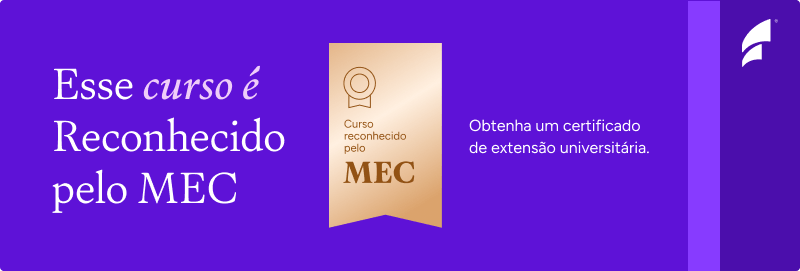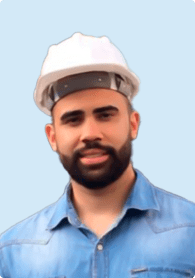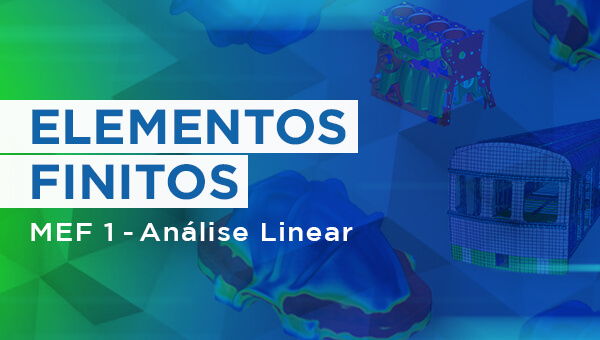For any questions, please contact directly [email protected]
This course explores the FUNDAMENTAL CONCEPTS MANDATORY IN THE USE OF CAE Technology – The Finite Element Method. Many professionals starting their applications in this area find difficulties in using CAE technology.
These difficulties arise from learning to use the software without satisfactory knowledge of the Finite Element Method, confusing this learning with understanding the Finite Element Method. Hence, the philosophy of the approach used here is justified:
IF THE ENGINEER CANNOT MODEL THE PROBLEM WITHOUT THE COMPUTER, THEY SHOULD NOT DO IT WITH THE COMPUTER.
In contrast to the previous view, learning so deeply the “mathematical techniques” of a long purely academic course raises the question: How to apply this knowledge in practice? Due to this approach, fear and discouragement towards the application of this knowledge emerge.
THE CENTRAL QUESTION BEFORE USING SOFTWARE ARE THE CONCEPTS !!!!!
Technology is knowledge. Empowering oneself in understanding, applying, and disseminating this knowledge is a topic that drives the technical society, but with little success. Academic institutions still maintain a certain distance from the technical problems of companies, which, in turn, being hostages of immediacy, still have difficulties in perceiving study and research as effective tools in solving their problems.
In the field of structural analysis, there are certainly Professors who have a deeper knowledge of theory, or even, we can find engineers within companies more involved in the task of applying this discipline. There is no doubt that Prof. Dr. Avelino has synthesized this knowledge in an efficient format and has become an absolute reference in Brazil.
His didactics have enchanted thousands of engineers across Brazil to the point of gaining recognition from major companies by introducing his courses as mandatory for their engineers. In several interviews in Brazil, he describes this nearly 50-year career story, among the challenges inherent in pioneering and the achievements attained through his seminal stance in the engineering community.”
Professor Avelino trained the main companies in Brazil with unprecedented methodology included in his Finite Elements books, such as:
Embraer, Petrobrás, Fiat, Iveco, Ford, Volkswagen, MWM Motors, Cummins, Randon. Brazilian Navy, MSC SOFTWARE/HEXAGON, Atlas Schindler, CNH, JAN ( Agrícola ), ZF, Meritor – Eixos de Caminhões, ELEB, Nokia, Samsung, BYD, Caterpillar, Military Engineering Institute, etc
The objective of this course is to introduce the fundamental conceptual foundation for the utilization, application of the softwares and understanding it.
Within this approach, we aim to introduce the Method’s concepts, supplemented by application exercises and practical examples of Structural Modeling carried out over our professional lives in the past 45 years (using FEM) in engineering works, with bi and three-dimensional applications.
This methodology constitutes a balanced view between necessary theoretical knowledge and practical application, serving as a starting point for those intending to develop themselves in this area.
The scope of this course is to provide the level of knowledge that allows professionals to subsequently apply the method’s resources using the Frons System in practical applications.
Course program covered: http://www.nce.com.br/mef1/
Subtitled by: Dr Carlos Okubo
The content of the ONLINE COURSES IS ABSOLUTELY IDENTICAL TO THE FACE-TO-FACE COURSES.
IN FACE-TO-FACE COURSES, STUDENTS HAVE TIME TO TRY TO SOLVE THE EXERCISES, WHICH ARE SOLVED LATER BY THE PROFESSOR AS IT IS DONE IN THE ONLINE COURSE. Therefore, in face-to-face courses, the number of hours is higher – 40 hours – because students do exercises. In ONLINE COURSES, the students can rewind the video as many times as they want to review the exercises. Also, they can repeat the tasks several times.
After the launch of this course, the already established Dynamic Analysis courses in Brazil will also be subtitled in English. Non-Linear Analysis and Fatigue Too
Subtitled by: Dr Carlos Okubo
- Building the foundation for the use of Finite Elements
- Studying the laws that applies to all finite elements
Step I – Concepts - Studying the laws that applies to all finite elements
Step II – The pillars – The laws - The first element – the spring.
The basis of all elements.
Step I – Element stiffness and structure stiffness - The first element – the spring.
The basis of all elements.
Step II – Element stiffness and structure stiffness – Stiffness matrix of the structure from the element stiffness matrix - The first element – the spring.
The basis of all elements.
Step III – Element stiffness and structure stiffness – Solving the system of equations - The first element – the spring.
The basis of all elements.
Step IV – Element stiffness and structure stiffness – Exercises and conclusions - The truss bars. Seeing the coordinate transformations. Local and global coordinate systems
Step I – Initial concepts and axial stiffness - The truss bars. Seeing the coordinate transformations. Local and global coordinate systems
Step II – Understanding the coordinates transformations. Local and global system - The beam element – Superposition of behaviors.
Step I – Beam bending. Bending moment, curvature, shear forces, normal and shear stress - The beam element – Superposition of behaviors.
Step II – Formulating the beam element. Stiffness matrix in plane and in space - The beam element – Superposition of behaviors.
Step III – Performing a computational application of beams - The behaviors of structural mechanics
and how they appear in the models
Step I – Beams, plates, solids and thin wall beams - The behaviors of structural mechanics
and how they appear in the models
Step II – real example - Preparing the basis for the 2D and 3D worlds. Interpolations.
Step I – Presenting the basis. The “exact” and the approximation - Preparing the basis for the 2D and 3D worlds. Interpolations.
Step II – Starting and interpolating in the beam element - Entering the 2D and 3D worlds. Physical behaviors and real cases
- Establishing the basis for the formulation of 2D and 3D elements. Reviewing the theory of elasticity. Degrees of freedom.
Step I – Dividing in triangles and identifying DOFs - Establishing the basis for the formulation of 2D and 3D elements. Reviewing the theory of elasticity.
Step II – Brief review of plane and spatial elasticity - Starting the formulation of the elements and verifying the software.
Linear triangle in plane stress and linear solid tetrahedron.
Step I – Initial considerations. Formulating the plane stress linear triangle - Starting the formulation of the elements and verifying the software. Linear triangle in plane stress and linear solid tetrahedron.
Step II – Verifying the linear triangle and finding the ideal mesh - Starting the formulation of the elements and verifying the software. Linear triangle in plane stress and linear solid tetrahedron.
Step III – Formulating the linear solid tetrahedron and looking at practical applications - Formulating the linear rectangle for the plane stress
and the linear solid hexahedron and verifying the software.
Step I – Linear rectangle and plane stress - Formulating the linear rectangle for the plane stress
and the linear solid hexahedron and verifying the software.
Step II – Testing the linear rectangle for plane stress at the software and formulating the solid hexahedron - Formulating the parabolic triangle of plane stress and the parabolic solid tetrahedron and verifying on the software
Step I – Triangular parabolic element for plane stress - Formulating the linear rectangular plate element. Remembering the plate concepts for linear analysis.
Step I – Revising the plate theory for linear analysis - Formulating the linear rectangular plate element. Remembering the plate concepts for linear analysis.
Step II – Formulating the linear rectangular plate element - Formulating the linear rectangular plate element. Remembering the plate concepts for linear analysis.
Step III – Verifying the linear plate formulation at the software - Determining the stiffness matrix of an element using virtual work.
General expression of stiffness matrix of an element
Step I – Reviewing energy and work concepts - Determining the stiffness matrix of an element using virtual work.
General expression of stiffness matrix of an element
Step II – Determining the element stiffness matrix from virtual work - Isoparametric formulation in finite elements. Jacobian.
General formulation fo the method
Step I – Introduction to the isoparamtric formulation - Isoparametric formulation in finite elements. Jacobian.
General formulation fo the method
Step II – Jacobian and numerical integration - Isoparametric formulation in finite elements. Jacobian.
General formulation of the method
Step III – General formulation for linear structural analysis and final considerations - Isoparametric formulation in finite elements. Jacobian.
General formulation of the method
Step IV – Final considerations – parabolic triangular plate – singularities – practical examples of shell elements
You must log in and have started this curso to submit a review.
Abilities
- fundamental conceptual foundation for the utilization
- practical examples of Structural Modeling
- application of the softwares and understanding it
Metodologia de ensino retirada da University of Arkansas e California State University

Conheça a Frons Carreira
Desenvolva uma trilha de conhecimentos que vai te aproximar do futuro
Assinar Plano







